► Audi RS6 vs BMW M5
► Video: Teutonic twin test
► A 1200bhp power struggle
Audi’s hottest estate faces off against BMW’s benchmark saloon and AMG’s baffling, brilliant GT. Which is your preferred super-saloon of choice? Read on for our fulsome three-way Giant Test, and you can watch our video twin test as the Audi RS6 takes on BMW’s M5 in our film below.
Audi RS6 Avant: once more with feeling
BMW styles its M5 as the original super saloon, but the original super estate? That’s Audi with the 1994 RS2, key to which was quattro all-wheel drive – an innovation that helped humble machinery go much faster before the M5 was a twinkle in Munich’s eye. Fuse all that history, go up a size and you get the new 2020 Audi RS6 Avant, Ingolstadt’s rival to the BMW M5.
The two have been going head to head for four generations, and now there’s a new RS6 from Audi Sport to give that M5 a run for its money, though the Audi always has been an alternative, not a facsimile; all-wheel drive, auto gearbox, turbo torque, estate car body – these are all things the M5 never used to have.
If that sounds a bit sensible, this fourth-generation RS6 definitely doesn’t feel strait-laced as I hurry over to Wales to meet the BMW M5 and Mercedes-AMG GT 4-Door Coupe – the latter a less direct rival but a fascinating game-changer nonetheless. The RS6’s V8 thuds with bassy intent thanks to the optional Performance exhaust, and it’s explosive when I need to power past slower traffic.
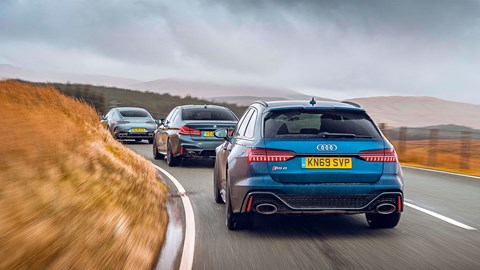
For the first time there’s rear-wheel steering and a quattro sport diff in the rear axle as standard (in the UK at least). There’s no question you feel rear bias and an unexpected agility when you carve the RS6 through corners. It’s more exciting and fun than its already brilliant predecessor, and I can’t make it understeer. What’s happening? This isn’t on-brand at all.
But this is not a tale of the RS6 moving towards dynamic M territory; the two might be converging but it’s BMW M that’s conceded most ground. So the latest F90 M5 not only evolves the old 4395cc twin-turbo V8, it’s also the first proper M car (yes, still having a dig at those M-badged SUVs) to get all-wheel drive and a torque converter auto. In this Competition trim it produces 616bhp and 553lb ft, and costs £96,475, but can M’s driver-focused qualities shine through all the extra hardware?
Into this mix we could have inserted the now middle-aged if still excellent Mercedes-AMG E63 S, which sits between RS6 and M5 in feel, and is also available with an estate body. But the AMG GT 4-Door Coupe 63 S (yes, that’s its full name) makes for the fresher, more interesting comparison. It basically drops the E63 S drivetrain into a saloon/coupe body, then turns up the wick and works all sorts of witchcraft on the chassis.
On price the AMG GT is the odd man out at £145,495, but its outputs of 630bhp and 664lb ft are comparable. So we’re intrigued: can the AMG really feel like £50k more car against rivals as polished, powerful and established as those from Audi Sport and M division?
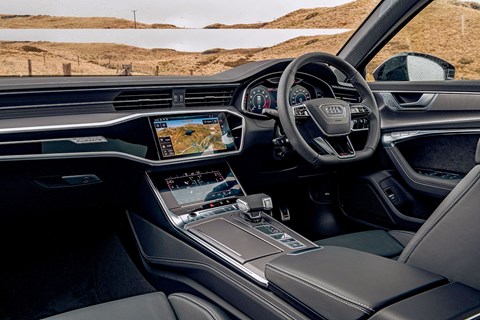
And the RS6 is certainly polished. This is not a radical overhaul of the previous generation, because the fundamentals remain untouched – it’s still a 4.0-litre twin-turbo V8 with an eight-speed auto, all-wheel drive and 80mm wider body (only the roof, tailgate and doors are shared with the vanilla A6). But this time 3mm-larger turbos help increase power to 592bhp and 590lb ft (up 39bhp and 74lb ft, though the old Performance model actually had 5bhp more, if 37lb ft less) and there’s a mild-hybrid system that stores otherwise wasted energy in a small lithium-ion battery, for a 22.6mpg best-case scenario – marginally better than the Merc; smashed by the non-hybrid M5’s 25mpg.
Despite the fairly small performance gain, the new RS6 feels significantly punchier than its 553bhp predecessor. Visually, it’s also better differentiated from an A6 thanks to a more aggressive front end lifted from the RS7. Inside you get the A7’s rear bench with integrated headrests, plus the technical precision and beautifully clean design of any A6 cabin (and slick if not always intuitive twin touchscreens) complemented by figure-hugging, super-comfortable sports seats, new RS1 and RS2 buttons for your individually configured drive modes, and an RS monitor that displays everything from tyre temperature to g-force.
There’s definitely a more aggressive edge to the ride compared with its predecessor, but also no question the RS6 is the long-distance champion of this trio, especially on our car’s optional air suspension. It rides better than an entry-level A6 on passive suspension and beats the BMW 330i Touring – my current long-term test car – on tyre roar, even on this car’s enormous 22-inch P Zero rubber. The adaptive suspension’s Auto setting works best – patter from each wheel in Comfort vanishes, the body does far less swilling about, and there’s just a calmer, steadier composure at a 70mph cruise, as well as sharper responses on more challenging roads.
Auto also helps dial the slack from the top of the Audi’s steering, which waggles about unconvincingly before suddenly leaping into action courtesy of the ‘strain-wave’ geared set-up that’s standard in the UK. It earns the wooden spoon here and is inferior to the more natural gearing and weight of the previous model’s standard set-up. Why bother?
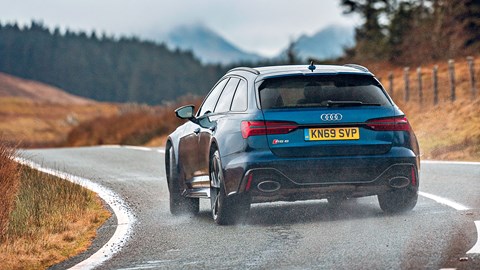
The handling, body control and driver feel are all clear improvements. You get more road texture and precision from the front, and a nice balance of very pronounced rear bias (up to 85 per cent, from the normal 40:60 split) with the sense the front tyres are helping out when you reach the limit. It still feels like the front tyres are carving a clean, uncorrupted arc, even if 70 per cent of power can reach them. Rear-wheel steering is subtly blended in to this mix, and only in slower and mid-speed corners taken more aggressively did I notice it at all.
When I blat through deserted country lanes and the matrix LED headlights banish the darkness, nothing can ruffle the RS6’s plumage – not weather, not surface, not tightening corners or shifting cambers. It just powers its way through the lot, without the aloofness that’s so often Audi Sport’s Achilles’ heel.
Some might wonder if the sleeker RS7 would have felt even sharper. But the RS6’s swollen arches and estate body are so much more appealing, and Audi chassis expert Andrei Filep tells me there’s just 10kg between the two, the track widths are identical and the chassis are tuned to feel the same. This is absolutely the RS I’d buy.
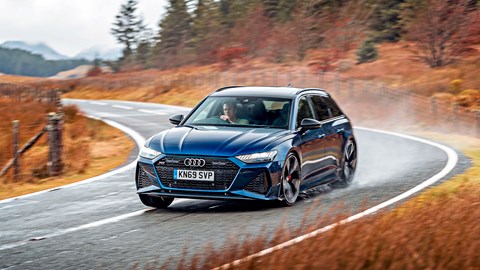
The Audi’s dynamism has its limits. The V8 doesn’t so much sparkle as have a stoic, endless resolve, the impressive eight-speed auto defers to civility more than all-out speed, and that rear-biased chassis never goes so far as actually wanting to oversteer (unless you throw it at a corner for a photographer).
It entertains to a point and then says ‘come now, you’re about to crash, stop this’ but right up to that point it brilliantly tip-toes between entertainment and failsafe security, and as Filep also says, the customers just don’t care about a drift mode.
When you factor in how comfortable, usable and practical it is for the driving most of us do, the RS6 is bang on target.
Mercedes-AMG GT 4-door: disconnect inferno
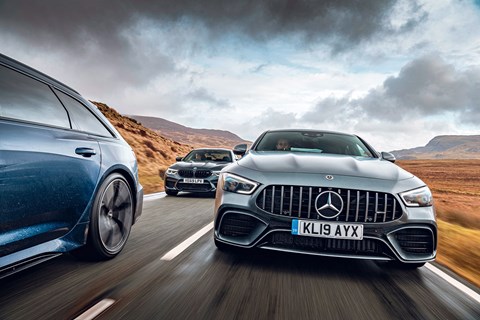
What you see and what you get in the AMG GT 4-Door Coupe are two almost entirely contradictory experiences, like someone’s projecting a strawberry smoothie into your eyes while slipping straight vodka to your taste buds. This is a five-metre-long Mercedes with a luxurious interior, including amazing massage chairs (plus a couple of quality clangers and largely fantastic infotainment let down by a dismal interface), but which drives like a sports car – a taut, aggressive, fang-bearing beast of a sports car.
Let’s be clear, the 4-Door is a fantastic thing to hoon about in like Lewis Hamilton on a quali lap, but it is a bit baffling, starting with a name that says four-door but a liftback tailgate that says five, and a body that’s very similar in concept to the existing CLS. The UK no longer gets an AMG V8 option for the CLS, but this hardly counts as proper differentiation.
The AMG starts life with the MRA platform of the E-Class estate, and takes AMG’s excellent twin-turbo 4.0-litre V8 engine and all-wheel drive. But from that shared DNA the two diverge spectacularly when AMG boss Tobias Moers instructs a team already partial to 98RON in the morning to go berserk – the result is carbon for the boot floor and rear bulkhead, dynamic engine mounts, a rigid subframe at the front, forged aluminium suspension components, a ‘shearing plate’ under the engine like you’d normally find to stiffen a wobblier cabrio, and steel reinforcement struts at the rear. All of it makes the AMG stiffer, more responsive; gritting its teeth and tensing its muscles before it moves an inch.
To that rigid base is added full air suspension, rear-wheel steering, standard carbon-ceramic stoppers, active aero and driving modes layered upon driving modes. It costs almost £50k more than an E63 S saloon at £145k in our car’s top 63 S spec. But get this: it’s 83kg portlier, and makes 630bhp and 664lb ft, or just 26bhp and 37lb ft more.
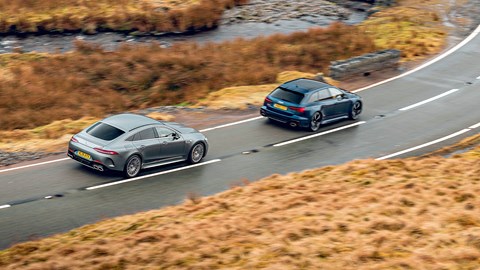
If that sounds underwhelming, there’s no doubting the AMG is shot through with exotic driving dynamics, though its more extreme focus on driver entertainment inevitably makes it a gnarlier daily proposition than either the RS6 or the M5, for good and for bad.
The 4Matic all-wheel-drive binds – unforgivably and uncouthly – in car parks like a hardy off-roader with diffs locked, and rides with an agitated fidget, even in its Comfort setting. It’s not uncomfortable, but it is unflinchingly firm and focused and with the pronounced tyre noise inevitable from a chassis with so little squish. You might notice the nine-speed multi-clutch transmission stumbles and thunks a little in gentle driving in its lowest ratios even in Comfort, but also that its shifts – controlled by gorgeous aluminium paddles when not left to the software’s own devices – are the snappiest here, blamming in Race-mode changes with a precision that makes the RS6 and M5 seem dozy.
There’s no compromise with the variable-rate electro-mechanical steering. It’s the best on test by a margin, with speed and accuracy but also feel through its tactile alcantara-wrapped rim like running your hands over the granulated surface.
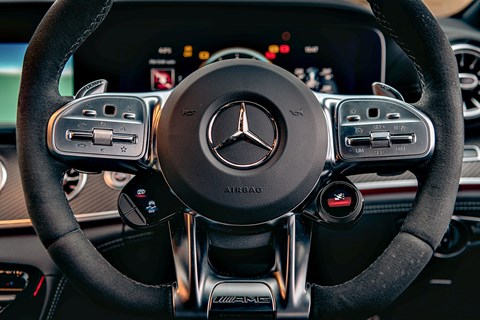
The 3982cc twin-turbocharged engine is a thing of wonder, like listening to a racing heartbeat through a stethoscope at lower revs and a top end like a terrible accident in a munitions factory, all complemented by very little lag and the promptest throttle response, partly thanks to ball bearings in the two twin-scroll turbochargers, a first for this engine. And it’s viciously quick, relentless in its delivery yet explosively multi-dimensional all at the same time.
What lets you tap all that ability is the 4Matic all-wheel drive, on a par with BMW’s M xDrive as a multi-talented set-up that’s able to claw as much grip from the surface as possible in regular settings, if with a very pronounced rear bias. Plus you can powerslide the AMG much like you can the M5 in the more aggressive modes if it’s wet, and there’s a full rear-drive Drift mode if you press buttons and pull paddles like accessing a computer game cheat mode. Again, not today – just didn’t need to.
When I took the AMG home from Wales, it eased me through gale-force wind and standing water on the motorway. And then cross-country, in better weather, it was so intense and pure I had to remind myself I was driving a four- or five-door saloon coupe thing. Body control, the agility gifted this lengthy car by such expertly integrated rear-wheel steering, the fizzy feel and the excitement – all belong to a hardcore sports car. But do people really exist who want a big car so extreme, so focused it feels like it could hound a 911 GT3 RS on a trackday? I’m not sure, and I’m still confused, even if I know this is a truly special car.
BMW M5 Competition: every good road deserves black lines
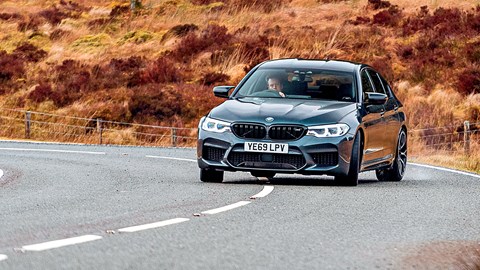
If the latest BMW M5 can’t match the RS6 for cushy cruising or estate-car practicality, it can still do comfort and usability. This is a spacious car with spectacular seats (torso-gripping support, doughy-soft comfort), an eight-speed auto that’s silky in the car park where the old DCT sometimes snatched, a V8 that ladles on torque from 1800 to 5800rpm for stress-free commutes, and M xDrive all-wheel drive that simply hooks up and fires you from bends like a pinged elastic band, even if you’re excitable with the throttle.
Drive the M5 quickly with all safety aids engaged and you’ll experience handling no more extrovert than this, which is probably on-target for a huge percentage of customers. But M loyalists will be pleased to hear that you can still find yourself in third gear in the wet with a third of a turn of opposite lock, the rear sliding and the V8 barking up towards 7000rpm. Certainly more effective than your morning coffee. In these filthy conditions I don’t even try rear-drive Drift mode – I don’t need to. Did someone forget to connect the front driveshafts?!
In fact, for all that BMW has relinquished – natural aspiration, DCT gearbox, rear drive – this M5 remains surprisingly faithful to the Jekyll and Hyde ethos of the original E28, happy to powerslide through the weekends but doing the nine to five in far less extrovert clothing than the actually more sensible RS6. If you want stealth with a wild streak, the M5 is your ticket.
Its turbo V8 wakes with a busy, bassy throb from a sports exhaust that sounds serious and just a little menacing. It’s part of the M5’s Competition-spec transformation, which is now also entry-level spec. These upgrades have lifted the M5 beyond the impressive if slightly muted drive I remember from the fleeting minutes (not bitter) I spent in Mark Walton’s 2018 M5 long-term test car to something altogether more talkative.
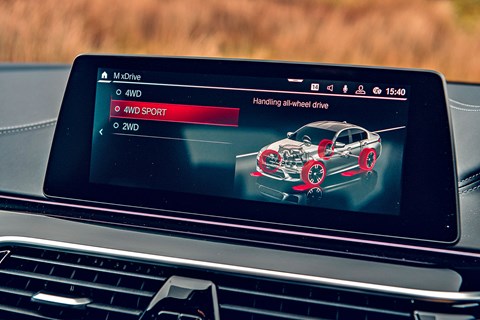
They include a 24bhp bonus for 616bhp, 20-inch forged alloys, stiffer engine mounts, a 7mm lower chassis with 10 per cent stiffer springs and a bespoke damper tune, increased front camber, front toe links with ball joints not squishier rubber mounts, and a stiffer rear anti-roll bar. Our test car adds carbon-ceramic brakes, a hefty £7.5k extra that helps lose 23kg – they’re crucial to not only the mighty stopping power, but also help reduce unsprung mass, improving handling.
The trade for all this faster/harder/more stuff is a stiffer-jointed ride, but it’s a million miles from intolerable, and you feel the extra dynamic sparkle almost as soon as you leave the car park, with a less heavy-handed touch and heightened response to this M5’s front end.
Feel from the fast-paced steering remains a little subdued, and it really needs to be in Sport because Comfort feels so flaccid, but it’s more consistent and just plain nicer than the RS6’s helm, and most importantly there’s a palpable sense of tyres interacting with road surface now, a layer of fuzz peeled away between chunky leather rim and Pirelli P Zeros.
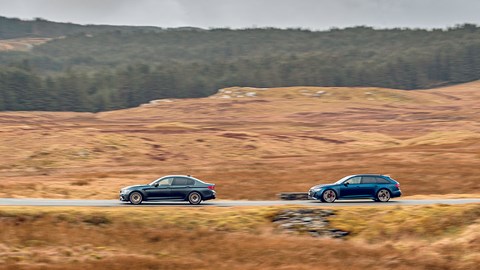
The extra touchy-feeliness encourages you to explore the limits, so you push and carve, working the all-wheel drive harder, becoming more engaged in the driving process with every corner, perhaps slackening off the stability control to MDM mode – a little nod that you’re happy for more oomph to go to the rear axle, and you realise that M xDrive actually is everything BMW claims, only bringing in the front tyres when the rears dial 999. Genuinely, the way they’ve calibrated the hardware and how it progressively becomes more unhinged as you loosen the electronics is genius. And no, you don’t long for rear-wheel steering.
The responsiveness and bandwidth of the V8 feels perfectly in tune with this driving experience, and makes the RS6’s delivery feel a little flat and one-dimensional in comparison, impressive and highly impressive though that engine is.
The M5 comes on boost from around 2000rpm so you can really exercise the all-wheel drive, it pulls flexibly in the midrange and suffers only fractional lag, then goes full rampaging madman as it reaches for the 7000rpm high notes.
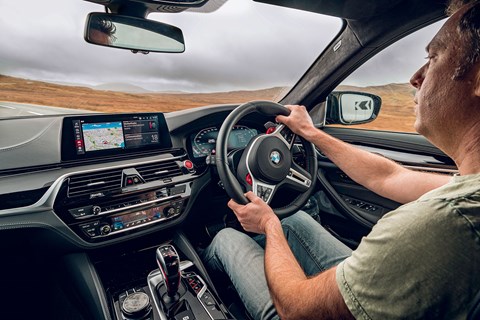
Pull the paddleshift and the eight-speed automatic can’t match the snap of the previous dual-clutch gearbox (it’s easy to catch it napping with a late first-gear shift and bosh the limiter), but in truth that does very little to detract from the intensity of the M5 driving experience.
Closer to an RS6 than ever it may be, but there’s no question this F90 generation is still very much an M5 in spirit, and a wildly different beast to the Audi too.
Verdict
Three extremely good, if imperfect, cars. Much of the fuss is around the new Audi RS6 and the less new but sensational BMW M5 Competition, but in many ways it’s the AMG that’s the truly astonishing machine.
It elevates the super saloon to a new level of driver focus, and does so with a cabin of spectacular opulence. The 4-Door 63 S’s handling, feel, performance and all-wheel-drive system – from total security to total hooligan in the blink of an eye – are all hugely appealing.
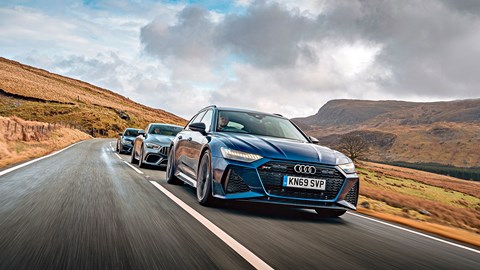
But this is also a super saloon that’s edging towards supercar money, and its hardcore focus has been achieved at the detriment of some comfort and refinement, which makes it tense to mooch about in. It’s also more cramped in the back that its rivals and I too frequently found myself fighting with the infotainment; I’d be least likely to buy the AMG.
It’s second place for the RS6. The best on test for daily comfort and practicality, arguably with the most desirable design and best-executed interior (bar the sometimes fiddly infotainment), and a chassis that manages to blend all-wheel-drive security with a huge spoonful of rear-biased driver focus.
That it has such a smooth, powerful, responsive and charismatic V8 only increases desirability. Ultimately the RS6’s rounded, secure nature makes it less exciting to drive than the others, but it’s highly involving and hard to fault as a package.
Which leaves the M5 spraying champers at the top of my podium, a car that strikes a sweet balance between the two poles of the Audi and the Mercedes. The Competition-spec upgrades have brought welcome extra tactility to the M5 chassis.
The V8 and eight-speed auto deliver flexible refinement with devastating performance. And it’s topped off by that seriously impressive M xDrive system, which seems to almost telepathically know whether you want to play it neat and tidy or send it like Ken Block.
I like the stealth factor of its exterior, the infotainment is the best here, the seats are just perfect and I’ll happily live with that firmer-edged ride given it’s so exciting to drive. That it’s the most frugal on fuel in this test and with the best APR rates only makes the decision easier.
One super-saloon/four-door coupe/estate car to do it all? My money’s on the M5 Competition.
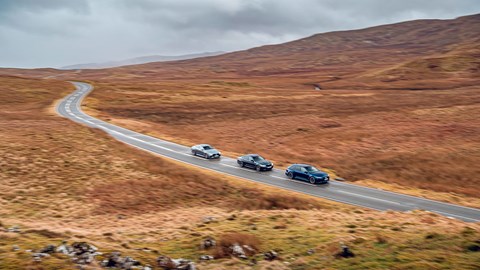
Audi RS6 vs BMW M5 Competition vs Mercedes-AMG GT 4-Door
First place: BMW M5
Captures the bi-polar brilliance of the best M5s – easy on the commute, unhinged otherwise
Second place: Audi RS6
Best for comfort and versatility, great exterior design and cabin; fantastic engine and dynamics
Third place: Mercedes-AMG GT 4-Door
Sensationally driver-focused, tactile and composed. But pricey, and comfort is compromised
More comparison tests by CAR magazine